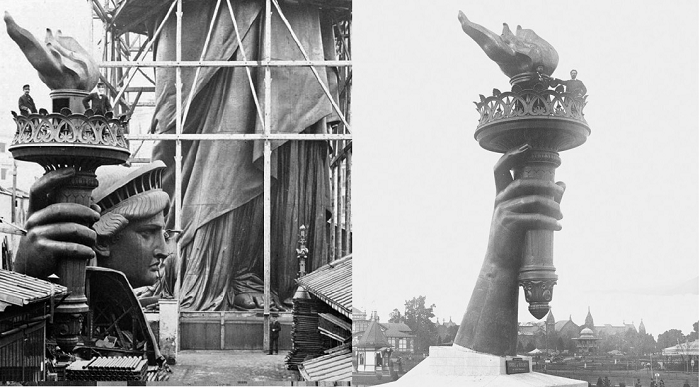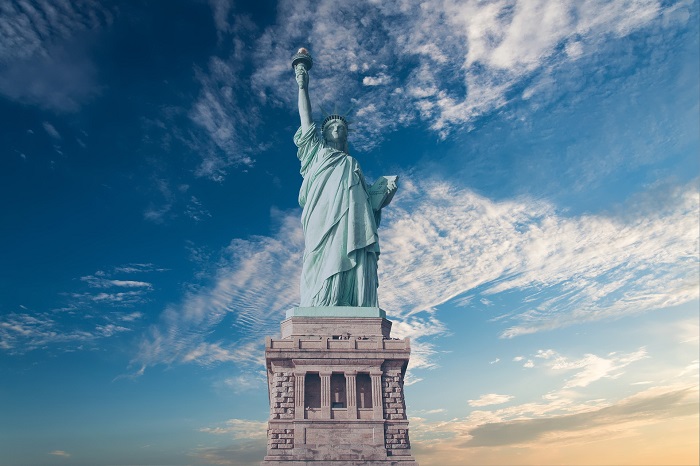ISABEL RUBIO ARROYO | Tungsteno
Towering 46 metres in height and weighing 225 tonnes, the proportions of one of the heaviest gifts in history—the Statue of Liberty—are astounding. On 4 July 1884, France gave this monumental gift to the United States to commemorate the centenary of its independence. Its design and construction were considered one of the greatest technical achievements of the 19th century. They gave shape to the most famous statue on the planet, which broke several records, from the tallest iron structure ever erected to the largest use of copper in a single structure.
A 46-metre-high gift
Although the Statue of Liberty is among the world's most famous sculptures, the story of its creation is little known, according to engineer Yasmin Sabina Khan's book Enlightening the World. In 1865, Édouard de Laboulaye, a French political thinker, jurist and anti-slavery activist, proposed that a statue be built to represent the liberty of the United States. The aim was to present it to the United States as a gift to commemorate the centenary of American independence and to cement an alliance between the two nations. Five years later, the French sculptor Auguste Bartholdi set to work and began designing the statue, christened Liberty Enlightening the World.
In 1876, a group of French craftsmen began to build the statue in France under Bartholdi's direction. It was constructed in parts. While the arm holding the torch was completed that same year, the head and shoulders were finished two years later and exhibited at the 1878 Paris Universal Exposition. Bartholdi and his team hammered approximately 31 tons of copper sheeting into a steel frame. The entire statue was completed and mounted in Paris and, on 4 July 1884, American Independence Day, it was presented to US politician Levi P. Morton.

A group of French craftsmen built the statue in France under Bartholdi's direction. Credit: Ellis Island Foundation.
This iconic structure stands over 46 metres tall and weighs 225 tons. Once mounted on its current pedestal, it reaches 93 metres in height from ground level to torch. Its design is laden with symbolism. While some historians link the statue's halo of sun rays to the Rising Sun Armchair immortalised by Benjamin Franklin, there are those who make a connection between the broken shackle and chains at the foot of Lady Liberty and the abolition of slavery. The statue depicts a woman holding a torch in her right hand, which is thought to represent the light that shows the way to freedom. In her left hand she also holds a tablet inscribed with 4 July 1776 in Roman numerals, noting the date of America's Declaration of Independence.
Heading for New York
Moving a statue of this size was a real challenge. To cross the Atlantic Ocean, it was reduced to 350 individual pieces, packed into 214 crates and shipped aboard the French naval vessel Isère. When it arrived in the United States on 17 June 1885, it received a triumphant welcome from New Yorkers. The next step was to mount it on Bedloe’s Island (renamed Liberty Island in 1956), south of Manhattan and near Ellis Island, which was the destination of millions of immigrants until 1943. Unfortunately, however, the pedestal was not finished and the structure would not be erected until 1886.
A construction crew, made up mostly of new immigrants, erected the statue at top speed. The first piece they assembled was the iron framework designed by Alexandre-Gustave Eiffel, the French engineer who later gained worldwide fame for his construction of the Eiffel Tower completed in 1888. The rest of the structure was reassembled not by scaffolding, but by steam-powered cranes. The final part to be completed was the statue's face, which remained covered with a French flag until its official unveiling.
The design and construction of the Statue of Liberty was considered one of the greatest technical achievements of the 19th century. Credit: Ellis Island Foundation.
Welcoming millions of immigrants
The most eagerly awaited moment came on 28 October 1886, when the Statue of Liberty that lights up the world was officially unveiled. The wet and foggy weather did not stop a million New Yorkers from flocking to see the unveiling, which was honoured with parades by land and sea. When Bartholdi removed the flag covering the face of the structure, a roar of cannon fire was accompanied by steam whistles from hundreds of ships in the harbour. Since then, many millions of people have admired the grandeur of this iconic statue.
One million New Yorkers attended the unveiling of the Statue of Liberty, which was honoured with parades by land and sea. Credit: Ellis Island Foundation.
To prevent potential damage caused by pollution, severe weather and large numbers of visitors, a number of regular checks and repairs have been carried out. For example, the inner iron strapwork that holds the metal skin in place was replaced in 1986 with stainless steel that will prevent corrosion. Being covered with a thin layer of copper, the structure has acquired a bluish-greenish colour due to the chemical reactions of the water with this material. All repairs have been carried out with great fidelity to the original design and materials. According to UNESCO, the design and purpose of the structure have been preserved from the time of its construction.
The Statue of Liberty has become an icon of New York and one of the most recognisable figures in the world, and has welcomed millions of immigrants to the United States. At the base of this monumental structure, a sonnet by the American poet Emma Lazarus remains engraved on a bronze plaque: "Give me your tired, your poor, your huddled masses yearning to breathe free, the wretched refuse of your teeming shore. Send these, the homeless, tempest-tost to me, I lift my lamp beside the golden door!"
· — —
Tungsteno is a journalism laboratory to scan the essence of innovation. Devised by Materia Publicaciones Científicas for Sacyr’s blog.
